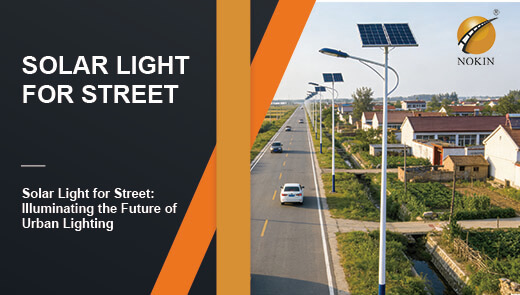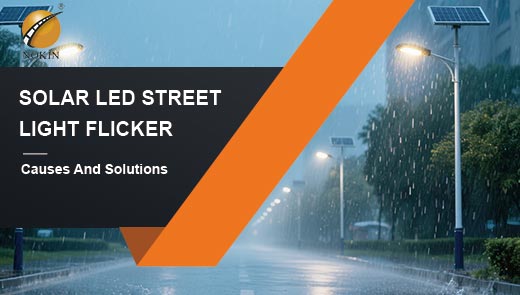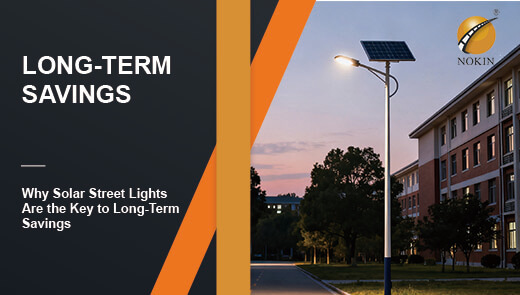How Much Sunlight Do Solar Street Lights Need?
In outdoor lighting projects, many people fall into the same confusion: "Solar street lights have been installed, but as soon as night falls, their brightness is insufficient or they even go out early. Could it be that the light is not enough?" In fact, light is the core variable that determines the performance of solar street lights, but it is not a single criterion - street lights in different scenarios and with different components have greatly different requirements and adaptability for light.
Next, NOKIN will start from the working principle, break down the light requirement standards of solar street lights, answer the adaptation questions for special scenarios such as cloudy days, winter, and shadow areas, and at the same time dispel common misunderstandings and provide practical optimization techniques to help you thoroughly understand "how much light does a solar street light actually need".
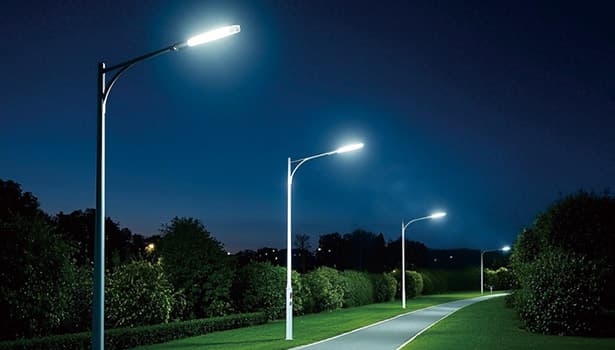
How Do Solar Street Lights Work?
To determine whether the sunlight is sufficient, one must first understand the energy conversion logic of solar street lights. In essence, it is a closed-loop system of "absorption - storage - release", and the performance of the core components directly determines the utilization rate of light.
The 3-Step Energy Cycle of Solar Street Lights
Step 1: Light absorption
Photovoltaic (PV) panels are the core for absorbing light, and the mainstream materials are monocrystalline silicon or polycrystalline silicon. When photons in sunlight hit the panel, the "photovoltaic effect" is triggered, converting light energy into direct current. At present, the conversion efficiency of mainstream panels is between 18% and 22%, which means that nearly one fifth of the light energy is converted into usable electrical energy.
Step 2: Energy storage
The converted direct current flows into rechargeable batteries, which are commonly lithium batteries or nickel-metal-hydride batteries. Take a 2000mAh lithium battery as an example. After being fully charged, it can support a 10-lumen LED light to work continuously for 8 to 12 hours. However, it should be noted that the battery will deteriorate with use - its capacity may drop by 30% after 2 to 3 years, and even with sufficient sunlight, the battery life will be shortened.
Step 3: Automatic lighting
The light sensor built into the street light will trigger the LED to light up at dusk. The power consumption of the LED light is extremely low, only 0.5 to 2 watts, and it can efficiently utilize the energy stored in the battery. Some high-end models also come with dimming modes (such as automatic brightness reduction at night) or human body sensing functions, which can extend battery life when there is insufficient light.
The Relationship between Solar Street Lights Key Components and Light
Under the same lighting conditions, the performance of street lights with different components can vary greatly. The core differences lie in two points:
- Panel material: The silicon crystal structure of monocrystalline silicon panels is more uniform. Their conversion efficiency in low-light environments (such as cloudy days and evening) is 3-5 percentage points higher than that of polycrystalline silicon, making them more suitable for areas with insufficient light.
- Battery performance: Lithium batteries are more sensitive to temperature. In a high-temperature environment above 35℃, the degradation rate is twice that of a 21℃ normal-temperature environment. Although nickel-metal-hydride batteries have a lower cost, they lose 15% to 20% of their power each month due to "self-discharge", which is equivalent to indirectly wasting part of the energy converted from light.
How Much Sunlight Do Solar Street Lights Need?
So, exactly how much light is needed for solar street lights to work stably? The answer is not a fixed value but is directly linked to "direct sunlight duration" and "battery life requirements".
Optimal Lighting Standard
According to industry data, most solar street lights require 4 to 10 hours of direct sunlight to fully charge their batteries. The specific endurance performance can be referred to the following corresponding relationship:
If 4 hours of direct sunlight can be obtained every day: The battery can store sufficient energy to support the LED light to work for about 6 hours at night, meeting the basic lighting needs (such as community walkways and courtyards).
If 8 hours of direct sunlight can be obtained every day: The battery capacity can be fully saturated. Some high-end street lights (such as large-capacity lithium batteries + low-power leds) can achieve a battery life of more than 15 hours, and even meet the energy replenishment needs on cloudy days the next day.
If the direct sunlight duration is less than 3 hours: The battery cannot be fully charged, and problems such as "premature extinguishing at night" and "sudden drop in brightness" may occur. Other optimization methods need to be adopted (detailed explanations will be provided later).
The Importance of Direct Light
Many people are puzzled: "Why must it be exposed to direct sunlight?" Can't diffuse light work?" The core reason lies in the huge difference in energy density:
The direct sunlight at noon has an energy density of up to 1000W/㎡, and at this time, the charging speed of the panel is the fastest.
On cloudy days or under the shade of trees, the diffused light has an energy density of only about 300W/㎡, which is one-third of that of direct light, and the charging speed will be significantly slowed down.
Even a slight obstruction (such as the shadow from tree branches or utility poles) can reduce the panel's output power by 50% - equivalent to a battery that originally took 8 hours to fully charge now requiring 16 hours, directly resulting in a reduction in battery life.
Solar Street Lights Installation Orientation
To obtain sufficient direct light, the orientation of installation is crucial. The solar trajectories vary in different hemispheres and require targeted planning:
Northern Hemisphere (such as China and the United States) : Prefer positions facing south, as they receive the longest period of direct sunlight throughout the day. If the site conditions limit, either the east or west direction is acceptable. However, it should be noted that the east direction can only receive morning sunlight, while the west direction can only receive afternoon sunlight. Adjustments should be made based on the battery life requirements of the street lights.For the Southern Hemisphere (such as Australia and Brazil), it is necessary to give priority to locations facing north, as the principle is the opposite of that in the Northern Hemisphere.
In addition, the photovoltaic panels should face the sun directly. The amount of light captured can be increased by adjusting the tilt Angle (such as 30°by default and 45°in winter) to avoid energy waste caused by the panels being "tilted towards the sun".
cLight Adaptability to Different Weather Conditions and SeasonsIn reality, we cannot guarantee that there will be sufficient direct light every day - cloudy days, rainy days and winter will all affect the lighting conditions. So, can solar street lights still work properly in these scenarios?
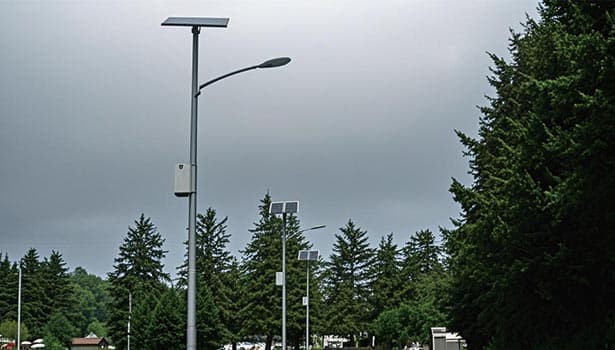
Can It Be Charged Normally on Cloudy or Rainy Days?
Cloudy days:
It can be charged, but the efficiency will be reduced. On a cloudy day, the diffused light can only enable the panel to receive 25% to 50% of its normal charging capacity. For instance, a battery that should be fully charged in 8 hours may take 16 to 24 hours on a cloudy day. In terms of night performance, street lights may be 20% to 30% dimmer than on sunny days, and their battery life may be shortened by 3 to 4 hours, but they will not be completely out of light.Rainy days:
Rainwater itself does not affect charging; instead, it has a "positive effect" - it can wash away dust and pollen on the panel, reduce shading, and indirectly improve the light conversion efficiency after rain. However, it should be noted that the thick clouds accompanying heavy rain will significantly reduce the intensity of light. At this time, the charging efficiency will decrease with the thickness of the clouds, similar to a cloudy day.What Should I Do If There is Short Sunlight and Snow Accumulation?
Winter is the "test period" for solar street lights. There are two core issues: shortened daylight duration and reduced solar altitude Angle, which will lead to a 30% to 50% reduction in the amount of light received by the panels. But as long as proper measures are taken, street lights can still work stably:
Clear snow in a timely manner:
Snow will completely cover the panel and block the light. After the snow stops, the accumulated snow on the panel should be cleared as soon as possible with a soft cloth or broom to prevent freezing (freezing can scratch the panel).Adjust the panel Angle:
In winter, the sun's trajectory is relatively low. You can adjust the panel's tilt Angle to 45° (about 15° higher than in summer) to make the panel more in line with the direction of the sun's rays and enhance the absorption efficiency.Select a split-type model:
If the installation location of the street light(such as the entrance of a residential area) has poor winter light but there are sunny areas nearby (such as rooftops or open Spaces), a "split-type solar street light" can be chosen - install the panel in the sunny area and connect the main body of the street lightthrough wires to achieve "remote supplementary lighting".3 Misconceptions About the Light Requirements of Solar Street Lights
In actual projects, many people choose the wrong street lights or installation locations due to misunderstandings, resulting in a poor user experience. The following are the three most common misunderstandings and the corresponding factual truths:
Solar street lights can only operate under direct sunlight and are completely useless on cloudy days.
Modern monocrystalline silicon panels can utilize scattered light (such as diffused light on cloudy days and dappled light under tree shade), but the charging speed will be 30% to 50% slower. For instance, a battery that originally requires 6 hours of direct sunlight to fully charge may take 10 to 12 hours on a cloudy day. In addition, reflective surfaces such as white walls and floor tiles can reflect the surrounding diffused light onto the panels, further replenishing energy.
In winter, the sunlight is short and solar street lights are completely unusable.
Winter only leads to a decline in efficiency, not "failure". By clearing the snow and adjusting the panel Angle, most street lights can still obtain 50% to 70% of the normal charging capacity, meeting the basic lighting needs for 6 to 8 hours at night (such as in community walkways and parking lots). If the demand for battery life is high (such as on main roads), a large-capacity lithium battery can be paired to further enhance the battery life in winter.
Solar street lights cannot be installed in shadow areas at all
Partial shadows :
The panel can still receive 50% to 60% of the light. For example, 3 hours of dappled light + 3 hours of diffused light can support 4 to 5 hours of night lighting, which is sufficient to meet the needs of courtyards, gardens and other scenarios.
Complete shade:
The panel hardly receives any light. At this time, a "split system" should be selected, with the panel installed in the sunny area, or traditional municipal street lights should be used instead.
How Can the Solar Street Lights Efficiency be Improved When There is Insufficient Sunlight?
If the lighting conditions at your installation site are limited, there is no need to give up solar street lights directly. By following these 4 tips, you can significantly increase the utilization rate of light and improve the performance of the street lights.
Installation and Adjustment
Select the optimal installation location:
First, use the mobile phone's sunlight analysis APP to predict the duration of sunlight at the site. Prioritize the area with no obstructions throughout the day and the longest sunlight exposure (such as the southern edge of the site or a location far from high-rise buildings).
Utilize reflective assistance:
Place reflective materials such as white metal plates or reflective films near the photovoltaic panels, or choose light-colored ground surfaces (such as white tiles) to reflect the diffused light from the surroundings onto the panels, which can increase the light absorption by 10% to 20%.
Seasonal angle adjustment:
Besides raising the Angle in winter, it should also be adapted to summer - in summer, when the solar altitude Angle is high, the panel Angle can be lowered to around 25° to prevent sunlight from "slanting" onto the panel and reduce energy waste.
Daily Maintenance
Dust, leaves, bird droppings and other substances on the surface of the panel can block the light. According to tests, a dust layer just 0.1mm thick can reduce the conversion efficiency of the panel by 20% to 30%. Therefore, daily maintenance is of vital importance.
Wipe the panel with a damp cloth once a month. If there are stubborn stains, you can clean them with a small amount of neutral soapy water. Avoid scratching with hard objects to prevent damage to the panel coating.
Regularly check the area around the panel for any newly grown branches or vines, and prune them in time to prevent new obstructions.
Standby Charging
In case of extreme weather conditions such as continuous rainy days or heavy snowfall, or if the site has long-term insufficient light (such as in winter in high-latitude regions of the north), the following methods can be used to "recharge" the street lights:
Artificial light charging:
Place the photovoltaic panels close to household LED lights or incandescent lights (10-20cm away) and use artificial light charging. It should be noted that the energy density of artificial light is much lower than that of sunlight. It takes about 12 to 16 hours to fully charge a 2000mAh battery, making it suitable for emergency use.
USB charging:
Some household or small solar street lights support USB charging. During the day, the battery can be recharged with a power bank or mains electricity to ensure normal operation at night.
Pair with a solar generator:
If the site has long-term insufficient sunlight, a portable solar generator can be used. The large-capacity battery of the generator can store sufficient energy, regularly recharge the street light battery, and also supply power to other devices, making it suitable for long-term outdoor scenarios.
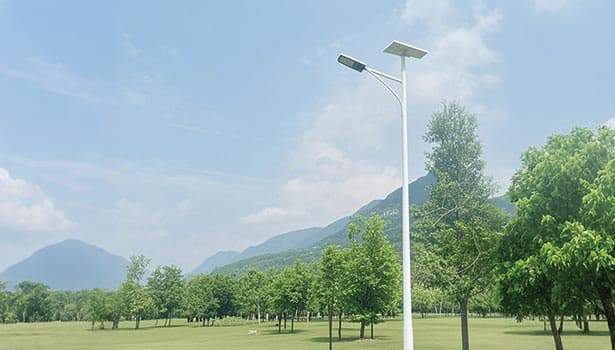
In summary, the core light requirement of solar street lights is "4 to 10 hours of direct sunlight per day", but this is not a "hard threshold" - by choosing the right components, optimizing installation, and doing a good job in maintenance, even on cloudy days, in winter, and in some shaded areas, the street lights can still work stably.
Solar street light manufacturers suggest conducting a "sunlight assessment" before installation. Record the duration of sunlight and shading conditions of the site through an APP or on-site observation, and then select the appropriate street light model based on your needs. As long as the planning is reasonable, solar street lights can become a "worry-free and energy-saving" choice for outdoor lighting.

